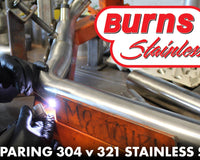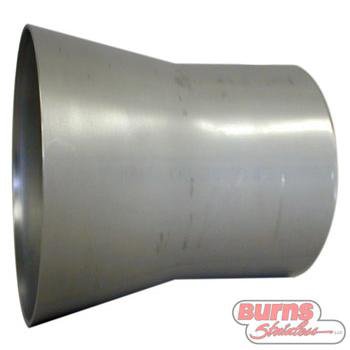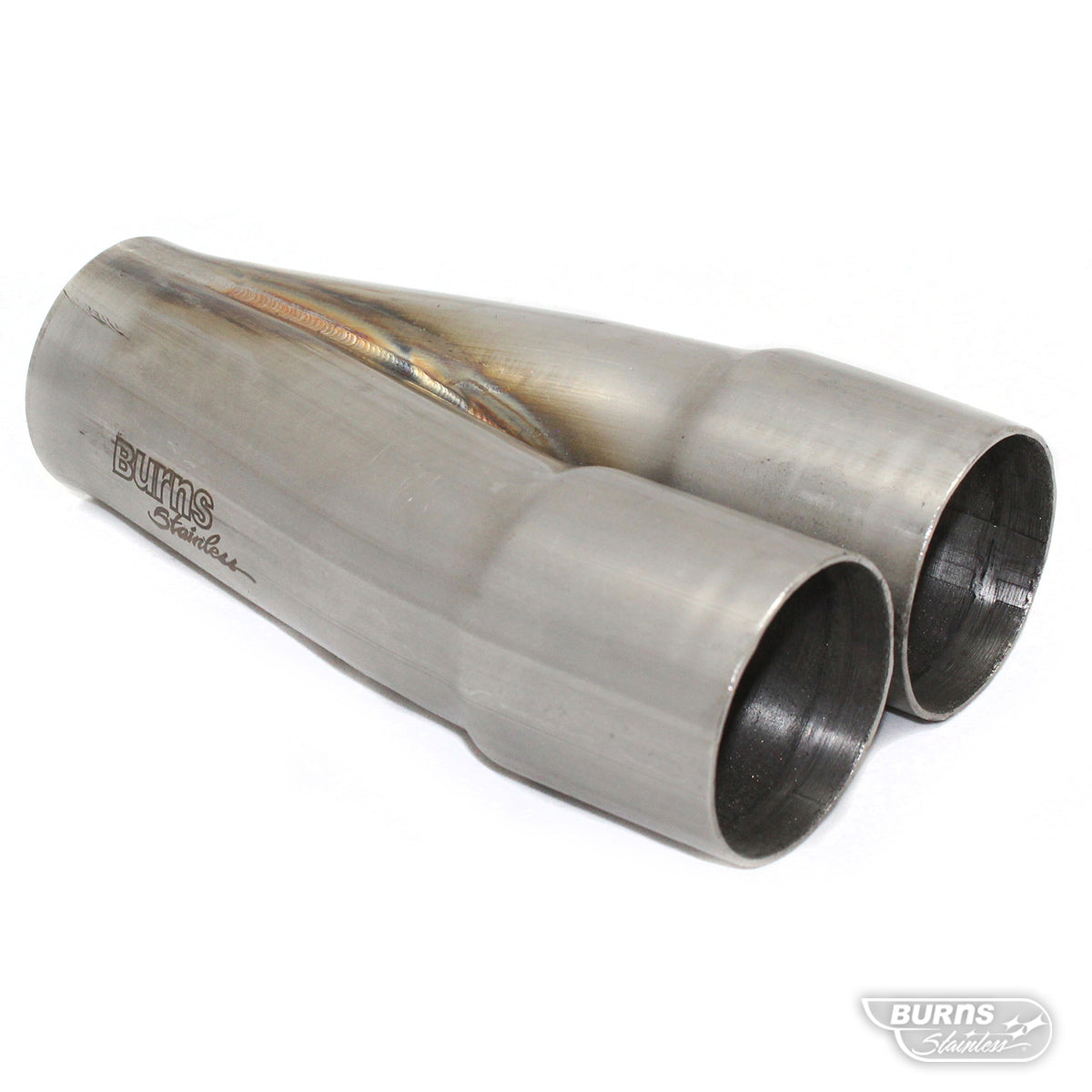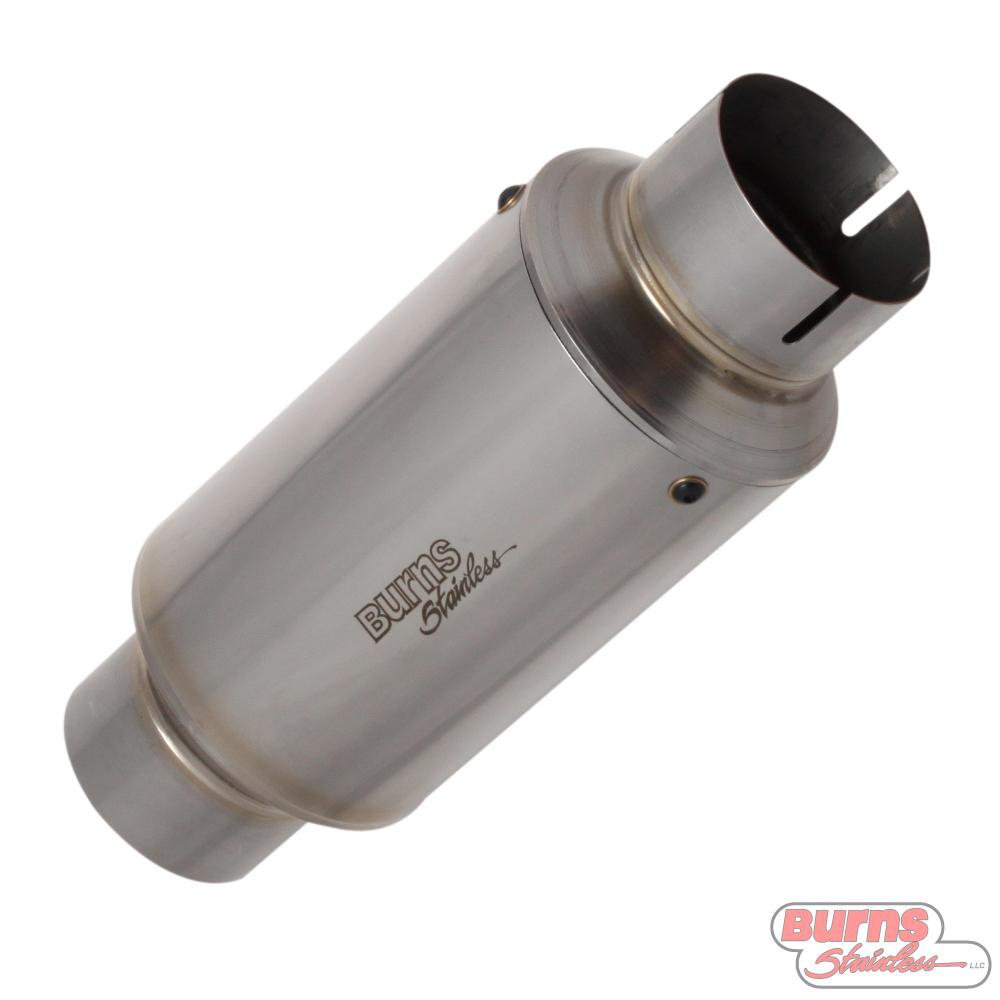When constructing racing headers, it is very important to make a logical plan before cutting any tubing. The design selection is the first step. Typically, the easiest and quickest way to ensure a good design choice is to use an existing, proven design as a basis for your new header. At this point a mock-up is unnecessary and you can proceed to making the actual stainless header.
If, however, you are starting from scratch then a new design is called for. The best bet on a fresh design is to consult with experts in the exhaust field (Burns Stainless is the obvious choice here) to get an idea for a good design. Those with years of dyno experience probably have a good idea of what they want, though even the best need some direction in this complex field. If you wish to take advantage of our X-design parametric computer header design program you can print the Race Engine Specification Form, complete it, and send it to us or use our handy online form. If you prefer, call Vinnie at 949-631-5120, or email to vince@burnsstainless.com
In most cases, it is best to make a mock-up header in mild steel before committing the design to stainless steel. The reason for this is that mild steel is easier to fabricate and is, of course, much cheaper to buy. Use the same radius mandrel bends in mild steel as you will use in the final stainless header. Also, a bend radius or two may change during the mock-up stage which will affect the stainless bends that you will need in the final header. Before the header mock-up is started, a mock collector(s) will have to be made. These are easily fabricated from steel tubing that is one size (1/8") larger and 18 gage (0.049") wall thickness. For example, a 1-3/4" 16 gage (0.065") final primary tube would call for a mock collector size of 1-7/8" 18 gage tube. Just cut 2" lengths, square them off and tack weld them together into an array that emulates the slip joints of the actual

collector. The advantage of using the mock collectors is that you can start right away while the real collectors are being made and the primary tubes can be made longer for exact trimming later. The mock collector can be mounted solidly to the chassis, bellhousing, etc. for a reference point when building the mock-up headers in the car, or be used as an alignment tool for building headers on the bench. Once you have built the mock-up header in the chassis, you can use a cylinder head mounted on the bench or an engine block on a stand to mount the mock-up to. Then the mock-up collector can be slipped on the primary tubes.
When laying out a prototype tube pack it is sometimes easier to visualize the routing by using flexible tubing (like a vacuum cleaner hose or other similar tube) in approximately the same diameter as the final tubing size. This works for only gross design reference as the actual tubing bends need to be in place for final mock-up construction and tube size ordering. When designing the tube pack routing, consideration should be made for equal length primary pipes (± 1/4" is good). This is much harder than it seems at first blush and when equal length is achieved, it is the mark of an accomplished header fabricator.

Now is a good time to talk about measuring tube length. Use a 1/4" wide steel tape measure (3' long is fine). It is crucial to measure only along the centerline of the bend. This means carefully moving the tape when the bend changes plane. It is also helpful to hold the tube in a vise or clamp when measuring. Sight directly over the centerline being measured. After a section is measured, mark the length with a felt tip marker at that point, then rotate the tube in the holding fixture as needed to continue measuring to the end. Keep the tape flat and rotate it under your finger as you "walk" the tape around the bend at 1/2" to 3/4" intervals. This takes practice, so be patient and make a habit of re-measuring at least twice. Start from the opposite end until both measurements are within 1/8".
Before the mock-up header is started, check the flange alignment on the head. Look for centering on the port, correct sizing of the flange hole (slightly larger than port to allow for tubing wall thickness) and if the mounting stud/bolts are a sloppy fit, then consider a positive location device for the flange. Typically, roll pins or stud dowels will solve the problem and give you good alignment. As the trend towards smaller primary tubes (including stepped headers) increases, then the flange-to-port interface must be carefully matched just as intake manifolds and heads are port matched. We are evolving towards port matched exhaust headers. Now is a good time to also check the gasket fit.The section of tubing coming off of the head flange should be aligned properly and not "cheated", either side to side or up or down. It is very important for the exhaust gases to enter the header tube in the same plane as the port itself (visualize the flange/tube interface as an extension of the port). A straight section or slight angle up with the direction of port flow is preferable, but not always possible. Many headers are built with a cheated radius angled downward at the flange, away from port flow, causing a disruption of exhaust flow and a loss of power. Be sure your header design does not make this mistake! Check that header bolts can be installed and removed at this time with wrench or socket clearance, and make sure spark plugs and socket can fit around your tubes.
A "cheated" tube radius is where a tubing bend is not cut perpendicular to the "tangent" line. The tangent line is a line perpendicular to a radius line. A line off-tangent would not be in line with the true radius. Both dashed cut lines in the diagram at right are perpendicular to tangent and intersect at the origin of the bend radius.

Any time two tubes are joined, they must be checked for alignment and be "on-plane" and tangent. Flow restriction is caused by cheated joints. Sometimes there is no choice due to space constraints and lack of a suitable bend radius, so some cheating may be necessary. Try to catch potential cheating in the mock-up stage and eliminate it as much as possible. Another tip is to try to use a bend with a straight section attached rather than to "piece" a tube together. A more professional appearance is made with the least possible weld joints. This can be accomplished when transferring from the prototype into the final stainless header.
When transferring the design to stainless steel, lay the prototype tube on top of the stainless tube to be cut to measure the cut line. For best results, do this on a well-lit workbench as you will need to look directly down over the prototype to eyeball where the witness line needs to be marked. Align the tube bend, then mark a line about a 1/2" long below the joint. Carefully extend the new cut line to make it tangent for the actual cutting. Allow some extra length (approx. 1/4") in the cut for "tune-ups". Measure the prototype tube section length and then compare with the new piece before cutting. If there are any differences in length, go back and fix the witness line until the measurements are the same. Witness lines are also used when preparing two tubes for tacking together. "Clocking" of the tubes is absolutely critical, so three witness lines are made across the joint. These lines are used to realign the tubes after they are removed from the setup and tacked. After tacking, the alignment must be rechecked in the setup.
 Cutting stainless steel can be a tricky part of the construction process. There are many methods used for cutting stainless steel. We suggest using a 14" two-wheel band saw unit run at almost friction cutting speeds. We run a “hot-rodded” 14” band saw with a 1725 rpm electric motor with a 2.5” motor pulley and 6” wheel pulley resulting in a blade speed of 2633 SPFM. You will need a 1-1/2 to 2 horsepower motor for enough torque at those speeds as stainless will bog down a 1 hp motor. Good service life is possible with carbon steel blades, 14-teeth per inch by 1/2" width raker set. Be careful when cutting stainless tubing with this setup as it cuts fast, but doesn't afford as much control as a slower speed would. When cutting on a band saw, line up the mark and watch for blade deflection. A trick for marking straight tubing for a cut is to first make the mark on the witness line with a hand-held tubing roll-cutter.
Cutting stainless steel can be a tricky part of the construction process. There are many methods used for cutting stainless steel. We suggest using a 14" two-wheel band saw unit run at almost friction cutting speeds. We run a “hot-rodded” 14” band saw with a 1725 rpm electric motor with a 2.5” motor pulley and 6” wheel pulley resulting in a blade speed of 2633 SPFM. You will need a 1-1/2 to 2 horsepower motor for enough torque at those speeds as stainless will bog down a 1 hp motor. Good service life is possible with carbon steel blades, 14-teeth per inch by 1/2" width raker set. Be careful when cutting stainless tubing with this setup as it cuts fast, but doesn't afford as much control as a slower speed would. When cutting on a band saw, line up the mark and watch for blade deflection. A trick for marking straight tubing for a cut is to first make the mark on the witness line with a hand-held tubing roll-cutter.
 Odd cuts, especially large diameter tubing, can be cut with a 14" abrasive cutoff saw. A cold saw that has a fine-tooth steel blade is best used to cut sections of straight tubing from stock. Because these cuts are true, they can be deburred and are ready for tacking. For cutting off tack welds, it is best to use a die grinder with a small abrasive wheel. A hack saw can be used for this as well. Just be careful to barely break through the tack weld without disturbing the actual joint face. Sometimes a light tap on the workbench is enough to break through the tack.
Odd cuts, especially large diameter tubing, can be cut with a 14" abrasive cutoff saw. A cold saw that has a fine-tooth steel blade is best used to cut sections of straight tubing from stock. Because these cuts are true, they can be deburred and are ready for tacking. For cutting off tack welds, it is best to use a die grinder with a small abrasive wheel. A hack saw can be used for this as well. Just be careful to barely break through the tack weld without disturbing the actual joint face. Sometimes a light tap on the workbench is enough to break through the tack.
After a tube is cut, then it must be ground to the proper length and angle. It is vitally important to grind flat. This is "eyeball" engineering at its best. Use a bench or pedestal disc grinder (12"-20" diameter) to grind your cut piece flat. Make sure that the grinding doesn't make one side shorter than the other. Hold the tube at arm's length and sight the joint surface in front of a well-lit background. As you rotate the tubing 90° in your hand, most irregularities will be seen; if the angle is off, it will show up. This takes practice to train your eye to see "cheated" grinding and is one area that separates the experienced fabricator from the neophyte. Use a straight section of tube or a T-square as a reference point to make sure you are grinding tangent. Lay the cut surface on a flat area and look for air gaps as a final check for flatness.
 When a stainless bend is cut, most of the time the cut bend section will not be round. This is a normal consequence of the bend process and must be fixed before fitting the tubes. After the tube is ground flat, deburr inside (with a die grinder with a spiral band abrasive or a plain round file) and out (with a 2" x 48" or similar belt sander). Squeeze the wide portion of the out-of-round tube in a vise until the tube shape is close to round, then use a T-dolly to hammerform the tube into shape. Eyeball the tube for roundness by looking down at the cut and rotating it in your hands. Any high or low spots can be touched up by hand with a sheet metal hammer. Lastly, retouch the surface grind on the disc grinder to make it flat again (as it will change as soon as you try to make it round), do final deburr and then you are ready to tack the joint. Just repeat the above many, many times.
When a stainless bend is cut, most of the time the cut bend section will not be round. This is a normal consequence of the bend process and must be fixed before fitting the tubes. After the tube is ground flat, deburr inside (with a die grinder with a spiral band abrasive or a plain round file) and out (with a 2" x 48" or similar belt sander). Squeeze the wide portion of the out-of-round tube in a vise until the tube shape is close to round, then use a T-dolly to hammerform the tube into shape. Eyeball the tube for roundness by looking down at the cut and rotating it in your hands. Any high or low spots can be touched up by hand with a sheet metal hammer. Lastly, retouch the surface grind on the disc grinder to make it flat again (as it will change as soon as you try to make it round), do final deburr and then you are ready to tack the joint. Just repeat the above many, many times.
 In addition to slightly deforming the roundness of the tube when it is bent on a mandrel bender, the metal is stretched slightly making the diameter smaller than a comparable straight piece of tubing. The only way to match up the diameters is to expand the smaller tube section. This is done with a tubing expander. Most muffler shops have large electrohydraulic units that work well if you have access to them. Hand held expanders (available from JC Whitney) can work for the small amounts of expanding needed in this case. Remember that stainless steel has a fair amount of spring-back, so some trial and error will be called for. Also, it is easier to make tubing larger than smaller, so take it in small steps. After expanding to size, check again for roundness and flatness.
In addition to slightly deforming the roundness of the tube when it is bent on a mandrel bender, the metal is stretched slightly making the diameter smaller than a comparable straight piece of tubing. The only way to match up the diameters is to expand the smaller tube section. This is done with a tubing expander. Most muffler shops have large electrohydraulic units that work well if you have access to them. Hand held expanders (available from JC Whitney) can work for the small amounts of expanding needed in this case. Remember that stainless steel has a fair amount of spring-back, so some trial and error will be called for. Also, it is easier to make tubing larger than smaller, so take it in small steps. After expanding to size, check again for roundness and flatness.
One of main reasons for all this attention to flatness and fitting is that when tacking and welding stainless steel, there can be no air gap between the pieces. A good test of flatness is to see if you can rock the two pieces of tubing when they are held in the tacking position. Even a slight amount of rocking will indicate that more tune-up is needed.
It is usually best to clamp one tube section in a vise (a machinist vice is good for this) while holding the other in one hand. Align the witness marks carefully while centering the tubes. This done by feeling the tube joint with your fingers 180° opposite each other, then rotate your hand 90° to check for alignment. There should be no overhang and adjust the tubes as needed.
 When tack welding the tubes together, use a low amperage setting. Using a TIG welder, the tacks should be fused only with no welding rod. Tack quickly to avoid melting and creating holes, but keep the torch cup close to the tack afterwards to benefit from a post purge to avoid oxidation. It helps to practice first on a sample, both to adjust the amps correctly and to improve your technique. If a hole is created in the tube while tacking, then the joint must be broken apart and reground or replaced.
When tack welding the tubes together, use a low amperage setting. Using a TIG welder, the tacks should be fused only with no welding rod. Tack quickly to avoid melting and creating holes, but keep the torch cup close to the tack afterwards to benefit from a post purge to avoid oxidation. It helps to practice first on a sample, both to adjust the amps correctly and to improve your technique. If a hole is created in the tube while tacking, then the joint must be broken apart and reground or replaced.
 After the first tack is successfully completed, rotate the tube 180° for the second tack. The two tube segments may have spread apart following the first tack. It is vitally important to hold the tubes tightly together when making the second tack. If the gap will not close, then the pieces probably were not flat to begin with. It is best to break it apart, touch up and start again. This can be tricky, so be patient and give yourself plenty of practice time. It also helps to be rested.
After the first tack is successfully completed, rotate the tube 180° for the second tack. The two tube segments may have spread apart following the first tack. It is vitally important to hold the tubes tightly together when making the second tack. If the gap will not close, then the pieces probably were not flat to begin with. It is best to break it apart, touch up and start again. This can be tricky, so be patient and give yourself plenty of practice time. It also helps to be rested.
 Two opposing tacks will do the job until the entire header is tacked. Two are preferably so the tube can be broken apart easily if a change is necessary. After the final changes are made, go back and add two more tacks to each joint for a total of 4 tacks at 90° intervals (approx.). It is recommended to use a freshly ground electrode (use the belt sander for this) with a long taper. For TIG welding use a 3/32" or 1/16" thoriated tungsten.
Two opposing tacks will do the job until the entire header is tacked. Two are preferably so the tube can be broken apart easily if a change is necessary. After the final changes are made, go back and add two more tacks to each joint for a total of 4 tacks at 90° intervals (approx.). It is recommended to use a freshly ground electrode (use the belt sander for this) with a long taper. For TIG welding use a 3/32" or 1/16" thoriated tungsten.
When it comes to final welding, the first choice is to use the TIG process, although MIG (wire feed) can be used. Because the 30% lower thermal conductivity and 50% greater coefficient of expansion of stainless, it distorts more in the area of the weld than mild and alloy steels. When welding a stainless header tube to a stainless 3/8" thick header flange, it is a good idea to use as low a heat setting as possible (TIG welds should be a shiny gold color verses dark grey and dull, which indicates too much heat) and cool it immediately by quenching it with air or water to minimize distortion. Preheat will accentuate distortion and should be avoided as much as possible. Sturdy, non-flexible welding fixtures also greatly minimize distortion if the part is allowed to cool before removal from the fixture.
 As for filler rod, always use an equal or higher grade of stainless than the material you are welding. For example, if you are welding 304, use a 308 wire or rod. If you are joining a stainless tube to a mild steel flange, use a 309 rod. Welds on 321 require a 347 filler rod, because 321 filler rods are not manufactured. Use .030" to .035" TIG rod for 18 and 16 gage tubing. Weld beads need to be slightly convex and definitely not concave.
As for filler rod, always use an equal or higher grade of stainless than the material you are welding. For example, if you are welding 304, use a 308 wire or rod. If you are joining a stainless tube to a mild steel flange, use a 309 rod. Welds on 321 require a 347 filler rod, because 321 filler rods are not manufactured. Use .030" to .035" TIG rod for 18 and 16 gage tubing. Weld beads need to be slightly convex and definitely not concave.
 Since stainless steel reacts with oxygen at welding temperatures forming oxides, technically known as ugly rough "noogies," back-purging with an inert gas (such as argon) provides a smooth inside weldment that is up to 30% stronger! This is referred to as back-purging because it purges, or displaces, ambient air inside the tube with a gas that does not contain oxygen. Back-purging is performed by capping both ends of the tacked-together tube and connecting an argon gas line to one end allowing a low continuous flow of gas into the tube during welding.
Since stainless steel reacts with oxygen at welding temperatures forming oxides, technically known as ugly rough "noogies," back-purging with an inert gas (such as argon) provides a smooth inside weldment that is up to 30% stronger! This is referred to as back-purging because it purges, or displaces, ambient air inside the tube with a gas that does not contain oxygen. Back-purging is performed by capping both ends of the tacked-together tube and connecting an argon gas line to one end allowing a low continuous flow of gas into the tube during welding.
In the case where back purging is not possible then the recommended course is to use a welding flux on the back side of the weld area. For this purpose, the best product on the market is SolarFlux type B. It comes in 1 Ibs. cans and can be conveniently brushed onto the back side of the weld piece.
Building stainless steel headers is a complex fabrication project. We hope these tips will help make yours successful. Good luck!
|
||||










